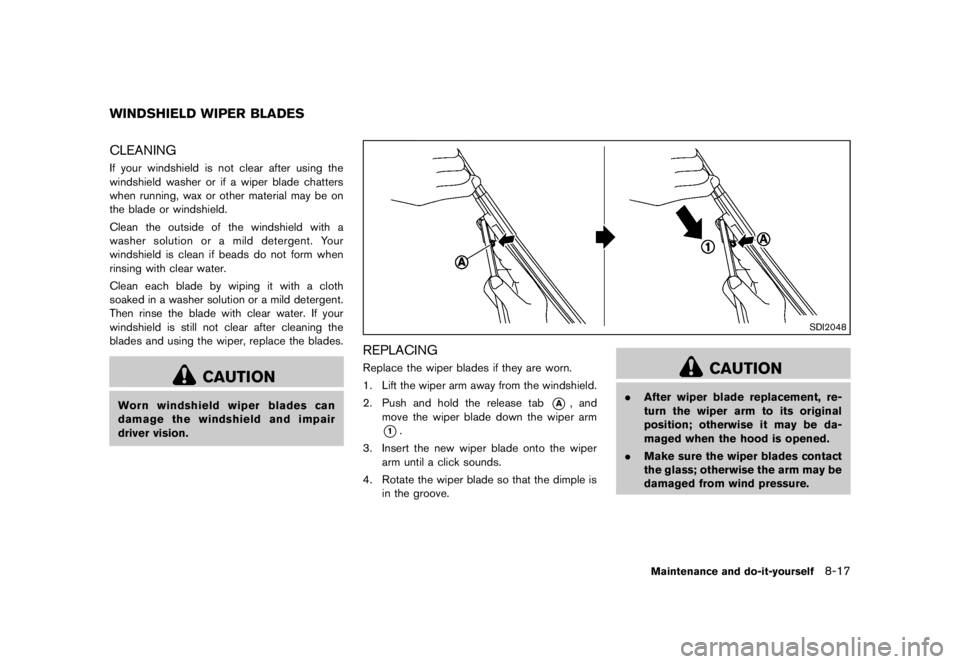2013 NISSAN ROGUE SPECIAL EDITION seats
[x] Cancel search: seatsPage 195 of 1113

Seat belt(s)Child safety ...
............................................................ 1-20
Infants ...
...................................................................... 1-21
Injured persons ...
..................................................... 1-13
Larger children ...
...................................................... 1-21
Precautions on seat belt usage ...
........................ 1-10
Pregnant women ...
.................................................. 1-13
Rear center seat belt ...
.......................................... 1-16
Seat belt cleaning ...
................................................... 7-6
Seat belt extenders ...
.............................................. 1-19
Seat belt hooks ...
.................................................... 1-16
Seat belt maintenance ...
........................................ 1-19
Seat belt warning light ...
........................................ 2-12
Seat belts ...
............................................................... 1-10
Seat belts with pretensioners ...
........................... 1-51
Shoulder belt height adjustment ...
...................... 1-15
Small children ...
........................................................ 1-21
Three-point type ...
................................................... 1-13
Seat(s) Heated seats ...
......................................................... 2-35
Seats ...
.......................................................................... 1-2
Security system (NISSAN Vehicle Immobilizer
System) , Engine start ...
................................................. 2-26
Security system, Vehicle security system ...
............. 2-25
Selector lever, Shift lock release ...
............................ 5-18
Servicing air conditioner ...
............................................ 4-29
Settings ...
.......................................................................... 2-23
Shift lock release Transmission ...
.......................................................... 5-18
SHIFT “P” warning ...
...................................................... 2-19
Shifting CVT (Continuously
Variable Transmission) ...
............................. 5-12, 5-14
Shoulder belt height adjustment ...
............................. 1-15
Sonar system ...
............................................................... 5-22
Spare tire ...
.............................................................. 8-40, 9-7
Spark plugs ...
.................................................................. 8-15 Sport mode switch
...
..................................................... 5-16
Starting Before starting the engine ...
................................. 5-13
Jump starting ...
............................................................ 6-9
Precautions when starting and driving ...
.............. 5-2
Push starting ...
......................................................... 6-11
Starting the engine ...
.............................................. 5-13
Status light, Front passenger air bag ...
.................... 1-46
Steering Electric power steering system ...
........................ 5-27
Steering wheel switch for audio controls ...
...... 4-67
Tilting steering wheel ...
.......................................... 3-23
Storage ...
.......................................................................... 2-38
Sun visors ...
..................................................................... 3-24
Sunglasses holder ...
...................................................... 2-39
Supplemental air bag warning labels ...
..................... 1-52
Supplemental air bag warning light ...
............ 1-52, 2-13
Supplemental restraint system ...
................................. 1-39
Precautions on supplemental
restraint system ...
..................................................... 1-39
Switch All-Wheel Drive (AWD) lock switch ...
................ 5-23
Audio control steering wheel switch ...
............... 4-67
Autolight switch ...
.................................................... 2-31
Fog light switch ...
.................................................... 2-34
Hazard warning flasher switch ...
............................. 6-2
Headlight aiming control ...
.................................... 2-33
Headlight switch ...
................................................... 2-32
Ignition switch ...
....................................................... 5-10
Overdrive OFF switch ...
......................................... 5-17
Power door lock switch ...
......................................... 3-5
Rear window and outside mirror
defroster switch ...
.................................................... 2-30
Sport mode switch ...
.............................................. 5-16
Turn signal switch ...
................................................ 2-34
Vehicle dynamic control (VDC) off switch ...
..... 2-36 System setup
...
................................................................. 4-6
T
Tachometer ...
..................................................................... 2-5
Temperature gauge, Engine coolant
temperature gauge ...
........................................................ 2-6
Theft (NISSAN Vehicle Immobilizer System) ,
Engine start ...
................................................................... 2-26
Three-way catalyst ...
........................................................ 5-3
Tilting steering wheel ...
................................................. 3-23
Tire pressure, Low tire pressure warning light ...
.... 2-11
Tires Flat tire ...
....................................................................... 6-2
Low tire pressure warning system ...
...................... 5-3
Tire and Loading information label ...
....... 8-32, 9-10
Tire chains ...
.............................................................. 8-37
Tire dressing ...
............................................................. 7-4
Tire pressure ...
......................................................... 8-31
Tire pressure monitoring
system (TPMS) ...
............................................... 5-3, 6-2
Tire rotation ...
............................................................ 8-38
Types of tires ...
......................................................... 8-36
Uniform tire quality grading ...
............................... 9-25
Wheel/tire size ...
......................................................... 9-7
Wheels and tires ...
.................................................. 8-31
Tonneau cover (see cargo cover) ...
........................... 2-41
Touch screen ...
.................................................................. 4-3
Towing Flat towing ...
............................................................. 9-24
Tow truck towing ...
.................................................. 6-12
Towing safety ...
......................................................... 9-20
Trailer towing ...
......................................................... 9-16
TPMS, Tire pressure monitoring system ...
................. 5-3
TPMS, Tire pressure warning system ...
...................... 6-2
Traffic setup ...
.................................................................... 4-8
Trailer towing ...
................................................................ 9-16
10-5
Page 212 of 1113

sensor to turn the air bag OFF. Always be sure
to be seated and wearing the seat belt properly
for the most effective protection by the seat belt
and supplemental air bag.
NISSAN recommends that pre-teens and chil-
dren be properly restrained in a rear seat.
NISSAN also recommends that appropriate
child restraints and booster seats be properly
installed in a rear seat. If this is not possible, the
occupant classification sensor is designed to
operate as described above to turn the front
passenger air bag OFF for specified child
restraints. Failing to properly secure child
restraints and to use the Automatic Locking
Retractor (ALR) mode (child restraint mode)
may allow the restraint to tip or move in an
accident or sudden stop. This can also result in
the passenger air bag inflating in a crash instead
of being OFF. (See “Child restraints” earlier in
this section for proper use and installation.)
If the front passenger seat is not occupied, the
passenger air bag is designed not to inflate in a
crash. However, heavy objects placed on the
seat could result in air bag inflation, because of
the object being detected by the occupant
classification sensor. Other conditions could
also result in air bag inflation, such as if a child is
standing on the seat, or if two children are on the
seat, contrary to the instructions in this manual.
Always be sure that you and all vehicleoccupants are seated and restrained properly.
Using the passenger air bag status light, you can
monitor when the front passenger air bag is
automatically turned OFF with the seat occu-
pied. The light will not illuminate when the front
passenger seat is unoccupied.
If an adult occupant is in the seat but the
passenger air bag status light is illuminated
(indicating that the air bag is OFF) , it could be
that the person is a small adult, or is not sitting
on the seat properly.
If a child restraint must be used in the front seat,
the passenger air bag status light may or may
not be illuminated, depending on the size of the
child and the type of child restraint being used. If
the air bag status light is not illuminated
(indicating that the air bag might inflate in a
crash) , it could be that the child restraint or seat
belt is not being used properly. Make sure that
the child restraint is installed properly, the seat
belt is used properly and the occupant is
positioned properly. If the air bag status light is
not illuminated, reposition the occupant or child
restraint in a rear seat.
If the passenger air bag status light will not
illuminate even though you believe that the child
restraint, the seat belts and the occupant are
properly positioned, the system may be sensing
an unoccupied seat (in which case the air bag is
OFF). Your NISSAN dealer can check that the
system is OFF by using a special tool. However,
until you have confirmed with your dealer that
your air bag is working properly, reposition the
occupant or child restraint in a rear seat.
The air bag system and passenger air bag status
light will take a few seconds to register a change
in the passenger seat status. However, if the
seat becomes unoccupied, the air bag status
light will remain off.
If a malfunction occurs in the front passenger air
bag system, the supplemental air bag warning
light
Page 213 of 1113

.Do not place objects with sharp
edges on the seat. Also, do not
place heavy objects on the seat that
will leave permanent impressions in
the seat. Such objects can damage
the seat or occupant classification
sensor (pattern sensor) . This can
affect the operation of the air bag
system and result in serious perso-
nal injury.
. Do not use water or acidic cleaners
(hot steam cleaners) on the seat.
This can damage the seat or occu-
pant classification sensor. This can
also affect the operation of the air
bag system and result in serious
personal injury.
. Immediately after inflation, several
front air bag system components
will be hot. Do not touch them; you
may severely burn yourself.
. No unauthorized changes should be
made to any components or wiring
of the supplemental air bag system.
This is to prevent accidental infla-
tion of the supplemental air bag or
damage to the supplemental air bag
system. .
Do not make unauthorized changes
to your vehicle’s electrical system,
suspension system or front end
structure. This could affect proper
operation of the front air bag sys-
tem.
. Tampering with the supplemental
air bag system may result in serious
personal injury. Tampering includes
changes to the steering wheel and
the instrument panel assembly by
placing material over the steering
wheel pad and above the instrument
panel or by installing additional trim
material around the air bag system.
. Modifying or tampering with the
front passenger seat may result in
serious personal injury. For exam-
ple, do not change the front seats by
placing material on the seat cushion
or by installing additional trim ma-
terial, such as seat covers, on the
seat that is not specifically designed
to assure proper air bag operation.
Additionally, do not stow any ob-
jects under the front passenger seat
or the seat cushion and seatback.
Such objects may interfere with the
proper operation of the occupant classification sensor.
. No unauthorized changes should be
made to any components or wiring
of the seat belt system. This may
affect the front air bag system.
Tampering with the seat belt system
may result in serious personal in-
jury.
. Work on and around the front air
bag system should be done by a
NISSAN dealer. Installation of elec-
trical equipment should also be
done by a NISSAN dealer. The
Supplemental Restraint System
(SRS) wiring harnesses* should not
be modified or disconnected. Un-
authorized electrical test equipment
and probing devices should not be
used on the air bag system.
. A cracked windshield should be
replaced immediately by a qualified
repair facility. A cracked windshield
could affect the function of the
supplemental air bag system.
* The SRS wiring harness connectors are
yellow and orange for easy identification.
When selling your vehicle, we request that you
inform the buyer about the front air bag system
Page 216 of 1113

SEAT BELTS WITH PRETENSIONERS
(front seats)
GUID-6661B209-8D93-4FE3-95C3-B230E4D4CC5D
Page 221 of 1113

may damage the USB device and
the port. Make sure that the USB
device is connected correctly into
the USB port.
. Do not grab the USB port cover (if
so equipped) when pulling the USB
device out of the port. This could
damage the port and the cover.
. Do not leave the USB cable in a
place where it can be pulled unin-
tentionally. Pulling the cable may
break the wire, USB device or the
port.
. To avoid damage and loss of func-
tion when using a USB device, note
the following precautions.
— Do not bend the cable exces-
sively (1.6 in (40 mm) radius
minimum) .
— Do not twist the cable exces- sively (more than 180 degrees) .
— Do not pull or drop the cable.
— Do not hit or press the USB port or USB device with hands, feet,
or objects.
— Do not store objects with sharp edges in the storage area where the cable is stored.
— Do not leave the USB device and attached devices in the vehicle
compartment. When not in use
for extended periods of time,
store the cable and USB device
in a clean, dust free environment
at room temperature and with-
out direct sun exposure.
— Do not use the cable for any other purposes than its intended
use in the vehicle.
The vehicle is not equipped with a USB device.
USB devices should be purchased separately
as necessary.
This system cannot be used to format USB
devices. To format a USB device, use a personal
computer.
In some states/area, the USB device for the
front seats plays only sound without images for
regulatory reasons, even when the vehicle is
parked.
This system supports various USB memory
devices, USB hard drives and iPod
®players.
Some USB devices may not be supported by
this system. .
Partitioned USB devices may not be played
correctly.
. Some characters used in other languages
(Chinese, Japanese, etc.) are not displayed
properly on display. Using English language
characters with a USB device is recom-
mended.
General notes for USB use:
GUID-D73A39BF-43C8-459F-9C24-47B7F579C407. The USB device may not function when the
passenger compartment temperature is ex-
tremely high. Lower the temperature before
use.
. During cold weather or rainy days, the player
may malfunction due to humidity. If this
occurs, remove the USB device and dehu-
midify or ventilate the USB player comple-
tely.
. Do not connect a USB device if a connector,
cable or USB port is wet. Allow the
connector, cable, and USB port to dry
completely before connecting the USB
device. (Wait for 24 hours or more until it
is dry.) If the connector and USB port are
exposed to fluids other than water, evapora-
tive residue may cause a short circuit
between the connector pins and USB port.
In this case, replace the cable and USB port.
Otherwise damage to the USB device and a
loss of function may occur.
Page 309 of 1113

The seat belt warning light for the front
passenger will illuminate if the seat belt is not
fastened when the front passenger’s seat is
occupied. For about 5 seconds after the ignition
switch is in the ON position, the system does
not activate the warning light for the front
passenger.
See “Seat belts” in the “1. Safety — Seats, seat
belts and supplemental restraint system” section
for precautions on seat belt usage.
Page 332 of 1113

TIRE DRESSINGGUID-AAEE2877-2189-40B9-920D-DCBC9F09133DNISSAN does not recommend the use of tire
dressings. Tire manufacturers apply a coating to
the tires to help reduce discoloration of the
rubber. If a tire dressing is applied to the tires, it
may react with the coating and form a com-
pound. This compound may come off the tire
while driving and stain the vehicle paint.
If you choose to use a tire dressing, take the
following precautions:
.Use a water-based tire dressing. The coat-
ing on the tire dissolves more easily with an
oil-based tire dressing.
. Apply a light coat of tire dressing to help
prevent it from entering the tire tread/
grooves (where it would be difficult to
remove) .
. Wipe off excess tire dressing using a dry
towel. Make sure the tire dressing is
completely removed from the tire tread/
grooves.
. Allow the tire dressing to dry as recom-
mended by tire dressing manufacturer.
S35-D-110201-587845C9-6398-4952-B930-68C63A2662F7Occasionally remove loose dust from the interior
trim, plastic parts and seats using a vacuum
cleaner or soft bristled brush. Wipe the vinyl and
leather surfaces with a clean, soft cloth dam-
pened in mild soap solution, then wipe clean
with a dry soft cloth.
Regular care and cleaning is required in order to
maintain the appearance of the leather.
Before using any fabric protector, read the
manufacturer’s recommendations. Some fabric
protectors contain chemicals that may stain or
bleach the seat material.
Use a cloth dampened only with water, to clean
the meter and gauge lens.
Page 334 of 1113

SEAT BELTSS35-D-110201-C770D13E-C383-46EE-A06C-46D1543B0A62The seat belts can be cleaned by wiping them
with a sponge dampened in a mild soap
solution. Allow the belts to dry completely in
the shade before using them.
See “Seat belts” in the “1. Safety — Seats, seat
belts and supplemental restraint system” sec-
tion.